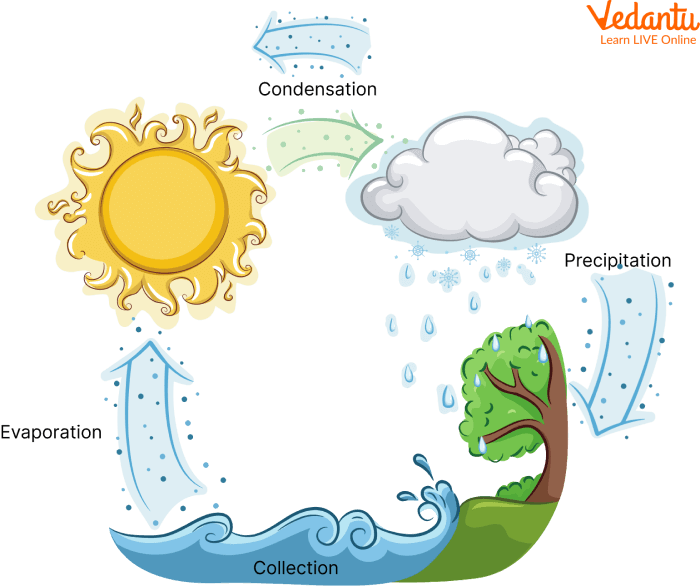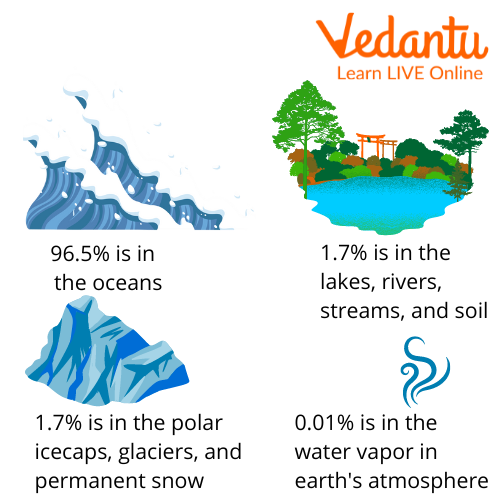




Introduction to Water Cycle
Throughout the day, water is perhaps the most important thing you need; after your P.E period, during your break, or after playing with your friends- water is usually what you seek to quench your thirst.
But do you ever stop to wonder where your water came from?
Here we will explore where water comes from, the water cycle as well as the process of the water cycle, and its importance.
What is the Water Cycle?
Water is one of the essential natural resources for humans. We use it most in everyday activities, such as cooking, cleaning, and so many more activities. Yet, the water that we use is more than 4 billion years old! The water that we drink today was the same water that the dinosaurs drank, the ancient Romans used and even the same water consumed by many animals worldwide. Water only changes its state from solid to liquid to gas, repeatedly. This process of the continuous movement of water through the earth and atmosphere in various states is known as the Water Cycle (or the Hydrological Cycle).
Water Cycle

Water Cycle Diagram
The Process of the Water Cycle
Water can be found everywhere- in lakes, glaciers, clouds, and yes, even underground! How does the water get there? How does the water from the lake travel to the cloud and then underground?
The Sun heats up the water in various water bodies which evaporate and change to water vapour. This then cools down and condenses, forming clouds where the water falls down to earth as precipitation in the form of- rain, snow, hail, or sleet. The water is collected in ponds, lakes, glaciers, and more, which we use.

Different Forms of Water
The Water Cycle is carried out through four stages: Evaporation, Condensation, Precipitation, and Collection.
Evaporation: This is the “process by which water(liquid) changes to water vapour (gas) due to heat.” In our case, the heat emanated by our Sun heats up the water that is in our lakes, seas, oceans, and various other water bodies, and mixes with the air around us.
Condensation: When the water vapour forms clouds containing water due to cooling, this is known as condensation
Precipitation: When the clouds accumulate too much water, they release their water through precipitation. This happens in different ways such as rain, hail, snow, or sleet depending upon the temperature.
Collection: The water from precipitation is then collected into various water bodies- seas, oceans, lakes, rivers, glaciers, ponds, and underground. This process is also known as “deposition.” The water collected or deposited is then evaporated and the water cycle continues.
The Importance of the Water Cycle
You may wonder, why exactly should we care about this? It happens by itself so how does it affect us and what we do? The Water Cycle is, in fact, very important to us and the survival of not only humans but also many species on this planet.
The water in lakes and rivers is important to us as that is where we get our drinking, cooking, and cleaning water for our basic day-to-day activities.

Uses of Water
The water contained in the soil and underground is also essential as we grow our plants in it, as well as rear different animals that eat these plants.
The water in oceans and seas contains various life forms that contribute to the beautiful diversity of this planet. Sometimes, we even consume some of these organisms, usually fish, crabs, lobsters, and other such organisms.
Summary
The Water Cycle refers to the continuous movement of water through the earth and atmosphere in various states-
The different stages of the Water Cycle are Evaporation, Condensation, Precipitation, and Collection.
The Water Cycle is important to us as we need it for our day-to-day activities. It also serves as the life source for various organisms.
In addition to this, we should also know that our water cycle may be in a precarious situation due to the actions of humans that contribute to global warming and water pollution. We need to come together to preserve the water that has been on this planet for our sake and for all the other organisms that we live with on this planet. The Water Cycle Chart plays an essential and irreplaceable role in the daily lives of all the inhabitants of Earth. We hope that you have learned what the water cycle is, its process, and the importance of water cycle through this.
FAQs on Water Cycle
1. Who discovered the Water Cycle?
Bernard Palissy, a Frenchman, discovered the water cycle in 1508 CE after observing coastal areas to have both salt and freshwater. Freshwater refers to water that does not contain salt and can be used by humans. This water used by us for drinking and cooking is known as “Potable water.”
2. How are clouds formed?
Clouds are formed when the evaporated water vapour in the air condenses at a high altitude and combines with the various dust particles. These clouds, upon being full and saturated, release their water by precipitation. There are, of course, various kinds of clouds, but the most common rain-bearing clouds are the “nimbus” or “cumulonimbus” clouds which are closest to the land. They can be identified by their dark grey colour and anvil shape.
3. Why is there water underground?
When it rains, the water accumulated on land seeps into the soil and contributes to the underground water table. This water may come from rainwater, melted snow, or water that leaks from lakes and rivers. Groundwater is usually clean and safe to drink (only when very deep) which is why we see people build wells to reach the underground water.









